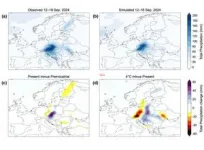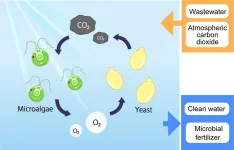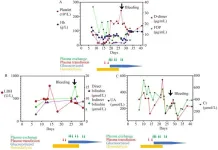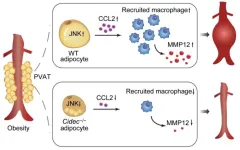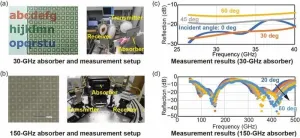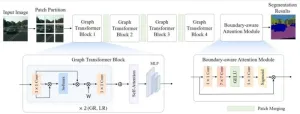(Press-News.org) Only a few weeks ago, massive precipitation produced by the storm “Boris” led to chaos and flooding in Central and Eastern Europe. An analysis conducted by the Alfred Wegener Institute shows that in a world without the current level of global warming Boris would have deposited roughly nine percent less rain. Such conclusions can be drawn thanks to a new modelling approach called ‘storylines’. How it can be used in near-real-time was just presented in the Nature journal Communications Earth & Environment. At the same time, the AWI team released a freely available online tool that allows users to identify the fingerprints of climate change in current extreme weather events and create their own comparison graphics.
In mid-September, the storm “Boris” produced torrential rains and extreme flooding in Poland, the Czech Republic, Austria and Romania. In many of the affected regions, it was one of the highest amounts of precipitation ever recorded in a five-day period. There were at least 27 fatalities, while countless families were forced to leave their homes. In the meantime, the situation has improved and cleanup efforts are running round the clock. But already the next weather extremes, this time in Spain, are cause for concern. Time and time again, a central question arises in public, political, and media forums: was the catastrophe caused by global climate change?
“For the past few years, science has been able to provide robust answers to this absolutely legitimate question,” says lead author Dr Marylou Athanase, a physicist in the Climate Dynamics Section of the Alfred Wegener Institute, Helmholtz Centre for Polar and Marine Research (AWI). “As early as one or two weeks after a given event, so-called probabilistic attribution studies can be used to draw initial conclusions on how much more probable the event was, due to climate change.”
The only problem: probabilities are often somewhat intangible, especially when they collide with concrete and exceptional, real-world events. When it comes to external communications – with the public and decision-makers – the scientific community has never had a tool that could show the influence of global climate change on the actual local weather in an impressive yet readily understandable way. “That’s why we at the AWI have worked so hard to advance a totally new way – the ‘storyline’ approach,” explains Dr Antonio Sánchez-Benítez, a fellow physicist in the Climate Dynamics Section and co-lead author of the study. “Essentially, we apply the ‘what if?’ principle. What would a given catastrophe look like in a world without climate change? And what about in a climate that was even warmer? By comparing the hypothetical scenarios with the reality, we can then very clearly identify the fingerprints of climate change – and not just for extreme weather events, but also for day-to-day weather.”
Using storm Boris as an example, the AWI experts have now demonstrated what the new approach can do in the Nature journal Communications Earth & Environment. A comparison of the scenarios shows: without global warming, Boris would have deposited roughly nine percent less rain. In reality, however, on its way from the eastern Mediterannean and the Black Sea toward Central Europe, the storm was able to gather in intensity because the water was roughly two degrees Celsius warmer than preindustrial levels – which meant a correspondingly higher percentage of water vapour in the air above the region. Nine percent might not sound like much, but when it comes to the consequences of heavy rains, it always comes down to how much water gathers on the surface and where it all goes – can a river, a dam, or a sewage system hold it, or does it spill over, doing tremendous damage in the process?
But how did the experts manage to connect climate model-based simulations, which are mainly designed for long-term trends, with the actual local weather? “One important aspect is what is known as ‘nudging’”, explains Dr Helge Gößling, a climate physicist and team lead of the storyline research at the AWI. “Climate models normally simulate a specific, quasi-random sequence of weather conditions, which is consistent with the laws of physics that their programming is based on. In order to identify differences in the climate, you need to see whether the mean values and distributions change, over a long period of time with a correspondingly large number of weather conditions. Likewise, in weather models the simulated conditions have very little to do with the reality after a few weeks; the actual weather can only be predicted to a limited extent. With the ‘nudging’, we provide the model with actually observed wind data, including phenomena like the jet stream, and we nudge the model a bit in the direction of the actually observed wind. In this way, we can accurately reproduce real weather in the real climate. Then we change the background climate of the model, for instance to a world untouched by climate change by reducing the greenhouse-gas concentrations and adjusting other aspects, and repeat the experiment.”
The model used is the CMIP6 version of the AWI climate model, which was also part of the base data for the IPCC’s Sixth Assessment Report. The wind data fed into the model stems from the ERA5 reanalysis produced by the European Centre for Medium-Range Weather Forecasts (ECMWF). “We have since automated the system to the point where daily analyses on the current weather are run on the supercomputer at the German Climate Computing Center (DKRZ),” says Marylou Athanase. “The data is then transferred to an online tool that runs on the AWI’s servers and is freely accessible to everyone at https://climate-storylines.awi.de. The analyses are conducted with a three-day delay on ‘real-time’, after which they’re available online. As a result, interested users can log on anytime to see the ‘Climate Change Signal of the Day’ for extremes and everyday weather, around the globe and in near-real-time, in the form of interactive maps and timelines, though for the time being, only data on the temperature and precipitation from 1 January 2024 onwards is available. Our goal is to promote a better understanding of the connections between climate change and extreme weather events, and to supply concrete and timely answers that can also be used in media coverage of these events.”
Original publication:
Marylou Athanase, Antonio Sánchez-Benítez, Eva Monfort, Thomas Jung, Helge F. Goessling (2024). How climate change intensified storm Boris’ extreme rainfall, revealed by near-real-time storylines. Nature Communications Earth & Environment; DOI: https://doi.org/10.1038/s43247-024-01847-0
END
How much climate change is in the weather?
New AWI simulations make it possible to compare actual extreme weather events in various climate scenarios, and to gauge the role of global warming in connection with these extremes in the process.
2024-11-08
ELSE PRESS RELEASES FROM THIS DATE:
Flagship AI-ready dataset released in type 2 diabetes study
2024-11-08
Researchers today (Nov. 8, 2024) are releasing the flagship dataset from an ambitious study of biomarkers and environmental factors that might influence the development of type 2 diabetes. Because the study participants include people with no diabetes and others with various stages of the condition, the early findings hint at a tapestry of information distinct from previous research.
For instance, data from a customized environmental sensor in participants’ homes show a clear association between disease state and exposure to tiny particulates of pollution. ...
Shaking it up: An innovative method for culturing microbes in static liquid medium
2024-11-08
Culturing, a term for growing microorganisms in the laboratory, is a basic yet indispensable method in microbiology research. Microorganisms are often cultured in a liquid medium that provides essential nutrients, and this process is both simple and highly effective. In addition to nutrients, oxygen availability is also critical for the growth of aerobic microorganisms. However, oxygen does not dissolve easily in the liquid medium. As a result, the medium needs to be forcibly aerated, usually by shaking.
Several techniques have been developed for better aeration of “shake” cultures, including “baffled” shake flasks, which have indentations designed to improve oxygen ...
Greener and cleaner: Yeast-green algae mix improves water treatment
2024-11-08
Bakeries and wineries can’t do without yeast, but they have no need for green algae. Wastewater treatment facilities, however, might just want to have these microorganisms team up. Osaka Metropolitan University researchers have discovered that these simple organisms form the best combination in terms of boosting wastewater treatment efficiency.
The active sludge method of wastewater treatment requires electricity to ensure the flow of oxygen that feeds bacteria and other organisms that process the water. Adding microalgae ...
Acquired immune thrombotic thrombocytopenic purpura (TTP) associated with inactivated COVID-19 vaccine CoronaVac
2024-11-08
The COVID-19 pandemic has prompted the rapid development and administration of various vaccines worldwide, with some reports linking these vaccines to immune thrombotic thrombocytopenic purpura (TTP). This report presents two cases of TTP occurring after the administration of the inactivated vaccine CoronaVac from Sinovac Biotech, highlighting the potential association between this type of vaccine and TTP. The article also provides an analysis of TTP incidence in the Nanjing area of China, suggesting a possible correlation between COVID-19 vaccination and the occurrence of TTP.
The first case details a 23-year-old female who developed symptoms of TTP three days ...
CIDEC as a novel player in abdominal aortic aneurysm formation
2024-11-08
Abdominal aortic aneurysm (AAA) is a degenerative lesion characterized by structural disruption of the abdominal aortic wall and progressive dilatation into a pulsatile mass. AAA is strongly associated with obesity, partly due to abnormal dilatation of perivascular adipose tissue (PVAT) in the abdomen, however, direct evidence is still lacking.
Cell death-inducing DNA fragmentation factor-like effector C (CIDEC), also known as fat-specific protein 27 (FSP27) in rodents, is a lipid droplet (LD)-associated protein that plays an important role in lipid storage. It has been reported that CIDEC/FSP27 promotes the growth of LDs by mediating the exchange and transfer of lipids ...
Artificial intelligence: a double-edged sword for the environment?
2024-11-08
As artificial intelligence (AI) technology progresses, the energy demands of training complex models have surged, raising widespread concerns about associated carbon emissions. This rapid growth is fueled by global demand across industries and academia, leading to exponential increases in computing power that carry significant environmental consequences. Given these challenges, in-depth research is essential to fully understand AI's carbon footprint and develop strategies for mitigating its environmental impact.
In a view (DOI: 10.1007/s11783-024-1918-y) by ...
Current test accommodations for students with blindness do not fully address their needs
2024-11-08
Tsukuba, Japan—Students often appear for high-stakes tests that hold significant weight in determining their futures. One such examination, the Common Test for University Admissions, currently allows examinees using braille an extended examination time of 1.5 times the standard duration. However, with the recent increase in complex questions and questions involving charts and diagrams in such tests, it is necessary to review whether the current accommodations remain adequate.
The researchers assessed the validity of the current time extension for examination questions containing complex tables by measuring the time required to read the text and complex tables. The results showed that ...
Wide-incident-angle wideband radio-wave absorbers boost 5G and beyond 5G applications
2024-11-08
5G wireless communication services have rapidly expanded worldwide, leveraging millimeter-wave (mmW) frequencies in the 24 GHz to 71 GHz range (referred to as frequency range 2, or FR2). Looking ahead, Beyond 5G and 6G services, projected to offer ultra-fast connectivity exceeding 100 Gbit/s, are expected to be introduced in the 2030s. Frequencies in the 150-GHz to 300-GHz range are being considered as potential candidates for these future networks. However, critical components such as radio-wave absorbers, essential for packaging and modularization, still need to be developed. These absorbers play a key role in reducing ...
A graph transformer with boundary-aware attention for semantic segmentation
2024-11-08
The transformer-based semantic segmentation approaches, which divide the image into different regions by sliding windows and model the relation inside each window, have achieved outstanding success. However, since the relation modeling between windows was not the primary emphasis of previous work, it was not fully utilized.
To solve the problems, a research team led by Zizhang Wu published their new research on 15 October 2024 in Frontiers of Computer Science co-published by Higher Education Press and Springer ...
C-Path announces key leadership appointments in neurodegenerative disease research
2024-11-08
TUCSON, Ariz., November 7, 2024 — Critical Path Institute® (C-Path) today announced key leadership appointments: Diane Stephenson, Ph.D., has been promoted to Vice President of Neurology, and Nadine Tatton, Ph.D., has been welcomed as the new Executive Director of C-Path’s Critical Path for Alzheimer’s Disease (CPAD) Consortium.
With over 30 years of specialized research in neuroscience and drug development and having served as the Executive Director of the Critical Path for Parkinson’s Consortium (CPP) for nearly 15 years, Dr. Stephenson has been an extraordinary partner in advancing our understanding ...
LAST 30 PRESS RELEASES:
Bluey’s dad offered professorial chair in archaeology at Griffith University
Beyond small data limitations: Transfer learning-enabled framework for predicting mechanical properties of aluminum matrix composites
Unveiling non-thermal catalytic origin of direct current-promoted catalysis for energy-efficient transformation of greenhouse gases to valuable chemicals
Chronic breathlessness emerging as a hidden strain on hospitals
Paleontologists find first fossil bee nests made inside fossil bones
These fossils were the perfect home for ancient baby bees
Not everyone reads the room the same. A new study examines why.
New research identifies linked energy, immune and vascular changes in ME/CFS
Concurrent frailty + depression likely boost dementia risk in older people
Living in substandard housing linked to kids’ missed schooling and poor grades
Little awareness of medical + psychological complexities of steroid cream withdrawal
Eight in 10 trusts caring for emergency department patients in corridors, finds BMJ investigation
NASA’s Webb telescope finds bizarre atmosphere on a lemon-shaped exoplanet
The gut bacteria that put the brakes on weight gain in mice
Exploring how patients feel about AI transcription
Category ‘6’ tropical cyclone hot spots are growing
Video: Drivers struggle to multitask when using dashboard touch screens, study finds
SLU research shows surge in alcohol-related liver disease driving ‘deaths of despair’
Rising heat reshapes how microbes break down microplastics, new review finds
Roots reveal a hidden carbon pathway in maize plants
Membrane magic: FAMU-FSU researchers repurpose fuel cells membranes for new applications
UN Member States pledge to increase access to diagnosis and inhaled medicines for the 480 million people living with COPD
Combination therapy shows potential to treat pediatric brain cancer ATRT
Study links seabird nesting to shark turf wars in Hawai‘i
Legal sports betting linked to sharp increases in violent crime, study finds
Breakthrough AI from NYUAD speeds up discovery of life-supporting microbes
New Eva Mayr-Stihl Foundation funding initiative boosts research at University of Freiburg on adaptation of forests to global change
The perfect plastic? Plant-based, fully saltwater degradable, zero microplastics
Bias in data may be blocking AI’s potential to combat antibiotic resistance
Article-level metrics would provide more recognition to most researchers than journal-level metrics
[Press-News.org] How much climate change is in the weather?New AWI simulations make it possible to compare actual extreme weather events in various climate scenarios, and to gauge the role of global warming in connection with these extremes in the process.

